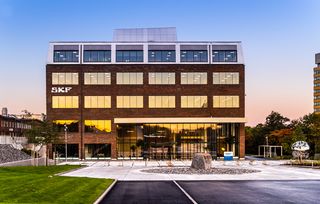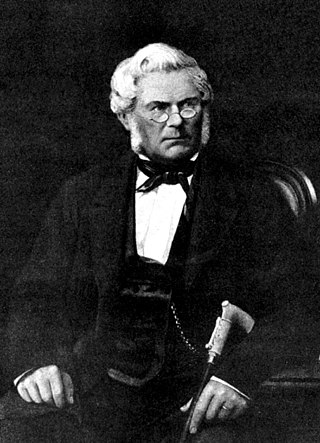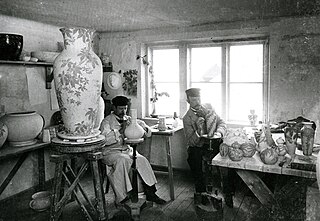

Axel Samuel Wilhelm Odelberg, (16 April 1873 in Gustavsberg - 25 November 1950 in Djursholm) was a Swedish chemical engineer. He was the son of industry owner Wilhelm Odelberg and the brother of Victor Odelberg. [1]


Axel Samuel Wilhelm Odelberg, (16 April 1873 in Gustavsberg - 25 November 1950 in Djursholm) was a Swedish chemical engineer. He was the son of industry owner Wilhelm Odelberg and the brother of Victor Odelberg. [1]
Odelberg graduated chemistry technical class in 1895 from Kungliga Tekniska högskolan in Stockholm. After his studies he travelled to Zürich to get education in ceramics. In 1895 he was employed as an engineer at Gustavsbergs porslinsfabrik that was owned by his father. In 1899 he became the lead-engineer and led the factories drive. The same year, he married Maud Jane Beavis (1873-1962, in London. He ran the continuation work at the porcelain productions methods and machine-park. Amongst other things he showed the superiority of electricity over steam-power. Electricity was first used at Gustavsberg in 1925. [1]
But Odelberg wanted to renew the production range and started to use Svenska Slöjdförening's program for more beautiful everyday goods. At his initiative he employed the artist Wilhelm Kåge whose work resulted in an internationally known everyday porcelain for the general public. Kåge later became the factory's artistic leader. [2]
Through his British wife he made connections with the owners of the British porcelain producers Wedgwood and became a goodwill ambassador in England for the Swedish industry. He became an honorary member of The Ceramic Society, he was later named as a pioneer by the same society. [1]

Ytterby is a village on the Swedish island of Resarö, in Vaxholm Municipality in the Stockholm archipelago. Today the residential area is dominated by suburban homes.

AB SKF is a Swedish bearing and seal manufacturing company founded in Gothenburg, Sweden, in 1907. The company manufactures and supplies bearings, seals, lubrication and lubrication systems, maintenance products, mechatronics products, power transmission products, condition monitoring systems and related services globally.

Värmdö Municipality is a municipality in Stockholm County in east central Sweden. Its seat is in the town of Gustavsberg, with a population of 9,682 (2005), on the main island at an elevation of 37 metres (121 ft).

Porcelain is a ceramic material made by heating raw materials, generally including kaolinite, in a kiln to temperatures between 1,200 and 1,400 °C. The greater strength and translucence of porcelain, relative to other types of pottery, arise mainly from vitrification and the formation of the mineral mullite within the body at these high temperatures. End applications include tableware, decorative ware such as figurines, and products in technology and industry such as electrical insulators and laboratory ware.

Immanuel Nobel the Younger was a Swedish engineer, architect, inventor and industrialist. He was the inventor of the rotary lathe used in plywood manufacturing. He was a member of the Nobel family and the father of Robert Nobel, Ludvig Nobel, Alfred Nobel and Emil Oskar Nobel. In 1827 he married the children's mother, Andriette Ahlsell. He also often experimented with nitroglycerin with his sons, which led to his son Emil Oskar's death because of an explosion at his father's factory Heleneborg in Stockholm in 1864.

Ludvig Immanuel Nobel was a Swedish-Russian engineer, a noted businessman and a humanitarian. One of the most prominent members of the Nobel family, he was the son of Immanuel Nobel and Andriette Nobel, and the older brother of Alfred Nobel. With his brother Robert, he operated Branobel, an oil company in Baku which at one point produced 50% of the world's oil.

Riedel Crystal is a glassware manufacturer based in Kufstein, Austria, best known for its glassware designed to enhance different types of wines. According to Petr Novy, Chief curator Museum of Glass and Jewellery in Jablonec nad Nisou, Czech Republic, Riedel is the oldest family owned and operated global crystal glass brand worldwide. Established in Bohemia in 1756, the company is managed by Georg Riedel and Maximilian Riedel. Later, it was re-established by Claus J. Riedel in 1956, with the support of the Swarovski family.

Mintons was a major company in Staffordshire pottery, "Europe's leading ceramic factory during the Victorian era", an independent business from 1793 to 1968. It was a leader in ceramic design, working in a number of different ceramic bodies, decorative techniques, and "a glorious pot-pourri of styles - Rococo shapes with Oriental motifs, Classical shapes with Medieval designs and Art Nouveau borders were among the many wonderful concoctions". As well as pottery vessels and sculptures, the firm was a leading manufacturer of tiles and other architectural ceramics, producing work for both the Houses of Parliament and United States Capitol.

Stig Lindberg was a Swedish ceramic designer, glass designer, textile designer, industrial designer, painter, and illustrator.

Adolf Arnold Louis Palander af Vega was a Swedish naval officer, mostly remembered as the captain on Adolf Erik Nordenskiöld's Vega expedition, the first successful attempt to navigate the Northeast Passage.

The Nobel family, is a prominent Swedish family closely related to the history both of Sweden and of Russia in the 19th and 20th centuries. Its legacy includes its outstanding contributions to philanthropy and to the development of the armament industry and the oil industry. Some of its foremost members are Immanuel Nobel the Younger, the engineer, developer of underwater naval mines and inventor of the rotary lathe used to produce plywood, Ludvig Nobel, the founder of Branobel and one of the richest and the most important men in Russia at his time, and Alfred Nobel, the inventor of dynamite who left the major part of his estate to the creation of the Nobel Prizes.

The Herend Porcelain Manufactory is a Hungarian manufacturing company, specializing in luxury hand-painted and gilded porcelain. Founded in 1826, it is based in the town of Herend near the city of Veszprém.

Fredrik Ljungström was a Swedish engineer, technical designer, and industrialist.
Grönvik glasbruk or simply Grönvik was a glassworks in the present-day Grönvik village in Korsholm, Western Finland. It was founded by merchant Johan Grönberg and existed from 1812 to 1907. Several glass manufactures were produced at Grönvik. At first bottles and drinking-glass were made here, but beginning in the 1890s solely window glass. Also pharmaceutical glass was manufactured. The glassworks produced as the first factory in Finland pressed glass, which came about from the 1840s. The domestic market for glass was during the time of the glassworks smallish and glassblowing products were exported to e.g. Lübeck, Saint Petersburg, Stockholm and Denmark, as well as to other parts of Europe. Grönvik was able to successfully assert its position, despite the competition from other glassworks in Finland. Eventually, it became the most distinguished in the country. The glassworks also become the largest in the Nordic countries.

Gustavsberg is a Swedish porcelain company that originated in 1826. It broke up in the 1990s and was sold off in pieces, to the dismay of residents of the Gustavsberg area, but artisans continued producing ceramics and household porcelain in the Gustavsberg tradition. One of Gustavsberg's most famous collections is the "Nobel Porcelain" produced in 1994. One such artisan was Josef Ekberg, who, even as a young man, created many pieces for Gustavsberg.

Rörstrand porcelain was one of the most famous Swedish porcelain manufacturers, with production initially at Karlbergskanalen in Birkastan in Stockholm.

Josef Ekberg was a Swedish designer who worked at the Gustavsberg Porcelain Factory from 1889 to 1917. He is known for his contributions to the Swedish Grace art movement.

Algot Wilhelm Kåge was a Swedish artist and designer, mainly known as a ceramic designer and as the artistic leader of the Gustavsberg porcelain factory.

Victor James Wilhelm Odelberg, was a Swedish hofjægermester. He was the son of Wilhelm Odelberg and the brother of Axel Odelberg.

Carl-Gustaf Victor Herlitz was a Finnish business director and Vuorineuvos. He was the managing director of the Arabia porcelain factory in Helsinki from 1916 to 1947, when the Herlitz family was a major owner of Arabia. During his time, Arabia expanded its operations and became the largest company in the Nordic countries in its field. Herlitz was a member of the board of the Finnish Confederation of Employers in 1921–1929 and 1937–1947, and a representative of the Swedish People's Party in the Helsinki City Council from 1931 to 1934. Herlitz was radical right-wing in his political views and advocated a hard line in relation to the trade union movement.